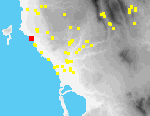 G01 Marathopolis Dialiskari
G01 Marathopolis Dialiskari
The church of Ayios Nikolaos is located on the coast, ca. 2.5 km. S of Marathopolis. Site G1 extends nearly a kilometer along the coast both N and S of the church and a maximum of 600 m. inland, bordered on the E by the modern asphalt road between Tragana and Marathopolis.[047.03]
Most of the site is relatively flat. Near the church, amidst old olive groves, are terraces with market-gardens; lines of reeds and maquis grow along their edges. The coast itself is rocky and barren. Development of beachfront properties is accelerating; the recent construction of several huge villas has done much damage to the site.[090.04] Fields near the asphalt road are mostly planted with olives; there are scattered modern houses (some with fenced compounds).
On the coast ca. 500 m. SE of Ayios Nikolaos there is a quarry. Immediately W of Ayios Nikolaos a large chunk of ancient walling abuts the south side of a small cinderblock building.[049.01] NW of the church is a small bay, now used by fishing boats for anchorage.[088.32] There are ancient cuttings[042.10], probably salt pans, in the rocky promontory that closes the bay on the N. Farther N along the coast are possible quarries.Valmin, UMME, and local scholars had previously noted ancient architectural features at Dialiskari; investigations by PRAP found others.
*Ca. 100 m. NW of Ayios Nikolaos, next to the dirt road leading to the church, is a modern house with ancient columns built into its veranda.[032.25] There is a fragment of a column E of the house, in its yard.
*Ca. 100 m. N of the previous house, there is a polygonal brick foundation, with at least four preserved sides.
*Part of a hypocaust with brick pillars and mortared walls can be seen in the scarp of a terrace immediately NW of the same house.[006.29] Geophysical investigations[098.16] demonstrated that the substructure of a Roman bath is preserved to the E, in the field adjacent to these remains.
*Ca. 300 m. NW of the house with the columns part of a Roman brick floor[049.19] and of a Roman mosaic[049.24] can be seen in the yard of another house.[022.17] Roman marble revetment[025.20] is preserved at the base of the W wall of this house, near its NW corner.
*Probably predating the Roman remains are poros blocks visible at the SW corner of the house.
*There are several unfluted monolithic columns and very large quantities of potsherds and tile in a fenced compound ca. 150 m. W of the house with the Roman mosaic.[006.31] We also found an inscription of the Early Roman period in the same location.
*There are seven rock-cut graves at the N end of the site, near the asphalt road.
Nearly all the pottery collected from this site is Hellenistic-Roman in date. It comprises a full range of table wares, storage and cooking vessels.